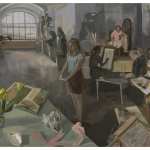According to his family, Thomas Kinkade, 54, aka Painter of Light, died in his Los Gatos, California, home yesterday of natural causes. [UPDATE: Looks like Kinkade may have died from causes related to alcoholism.) Best known for painting sentimental images of light-soaked rural life and his aggressive marketing techniques (“We also provide No Sales Tax, Low Price Guarantee, 12 month 0%
Financing, Free 6 month layaway, 100% Moneyback Guarantee within 5 days
of receiving, $10 Shipping.”), Kinkade filled mall shops across the country with mass-produced paintings, prints and other high-profit merch. In 2010, his company filed for bankruptcy, and recently rumors about fraud and corruption had surfaced. Let’s hope the hordes who bought his work aren’t expecting the value to increase.
Watch Kinkade’s video sales pitch for a painting called Christmas Cottage—–>
“A dream is coming true as work begins on
Home for Christmas, the first in a number of inspirational movies about
my difficult boyhood. As I re-live what were, despite many hardships,
golden years, I realize that God must have had a hand in some of our
miraculous escapes. The home payments we scraped together, the injuries
we barely avoided, the holidays we somehow managed to celebrate – these
are my small dramas. In the film, I’m at work, painting a study of
Christmas Cottage, — the radiantly lit, loving home that sheltered and
supported the development of my character. We are releasing the official
Christmas Cottage print especially for my many loyal collectors.”
——-
Subscribe to Two Coats of Paint by email.















I'm just sitting here in mourning for all the Chinese workers who are going to be laid off or transferred to the Hirst department. So sad.
Really, he made "art" accessable to the common man. How can you be upset about that. An original or a print whats the difference besides 100,000$? You see the same thing.
I am guessing that the so-called "hordes" you mentioned purchased his work because it spoke to them…not because they anticipated a monetary reward.
Who gets to define "good art" anyway? Hitler tried that, you know.Leave people alone. If they loved it, they loved it. We should all be so admired (no matter what his personal demons might have been.)
what a terrible blog post by sharon butler. mean, uppity, snobby, ignorant. period. i will not look at this blog anymore.
Actually, I thought this post was rather mild, given the vapid sentimentality of his work, and the cynical, hucksterish marketing approach he adopted. He was an artistic charlatan, a buffoon, a rapacious opportunist, and a hypocrite. The fact that he aggressively marketed his "deep christian faith" at every single opportunity is deeply disgusting to me.
Thankfully at least one representative painter in our times has made a name for themselves within their own lifetime. Mass marketeer or not, he did what he wanted. We should all have as much fortune.
Perlease- it's unmitigated, uninterrupted, manipulative kak with no discernable merit- in fact the kind of art that no self respecting nazi family should be without- come on say it loud- I'm discerning & proud! The only thing that is surprising is how unjudgemental is Sharon Butler's post; we'll miss you Anonymous
Kudos to the Times and to Sharon Butler for reposting this image of his piece, "Forest Chapel Painting". At first it seems like a perfect example of how antithetical his work is to the principles of truth, beauty and goodness.
But the irony of the image of an isolated chapel built so dangerously close to the bank of a mountain stream makes me wonder if he may have been a something of "real" artist after all. I'm left with the impression that he was able to communicate some truth about himself even if unintentionally. Was something in him saying if we ignore our problems, if we paint a pretty picture over them, if we indulge in our delusions, sooner rather than later we will find trouble?
The river's gonna rise.
Thomas Kinkade was kitsch genre painter who lived from 1958-2012. His bucolic subject matter was gobbled up by Middle America and he became famous, due to his genius of mass marketing reproductions. Bucolic is a term that refers to idyllic or pastoral ideals. Pastoral is a word that comes from the Greek word bucolic ???????? meaning a cowherd. Critics have referred to his work as kitsch art, cotton candy, or the Harlequin Romance, of the art world.
The English master J.M.W. Turner was the true �painter of light� he took landscape painting to whole new level and earned the title �The Godfather of impressionistic painting.� He didn't� toot his own horn; the name was given to him, by the Art Historians. On the other hand, Thomas Kinkade proclaimed himself �Painter of Light� and trademarked the term. If a musician attempted to trademark �player of notes� the public would consider this ridiculous and narcissistic. The sheeple buy into the Record Companies renaming Musicians �recording artists�, but that�s another debate, so I digress.